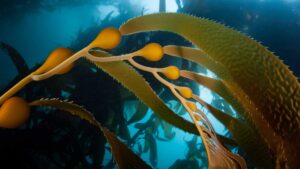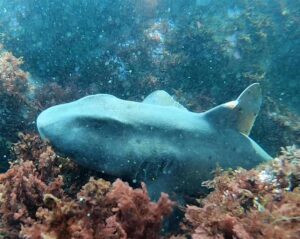Why You Should Get Into Cold Water Diving
There are a lot of myths about cold water diving.
There’s no color!
There’s nothing to see!
You’ll be shivering the entire dive!
If we had a nickel for every time we heard one of these, then we could probably buy ourselves a pretty good fish dinner, with lobster on the side.
Here at Dive California, we think that diving in cold water is AMAZING!! Otherwise, we wouldn’t have set up shop here in San Diego.
So let’s give you our top 7 reasons why cold water diving is awesome, whether you’re a scuba diver or freediver.
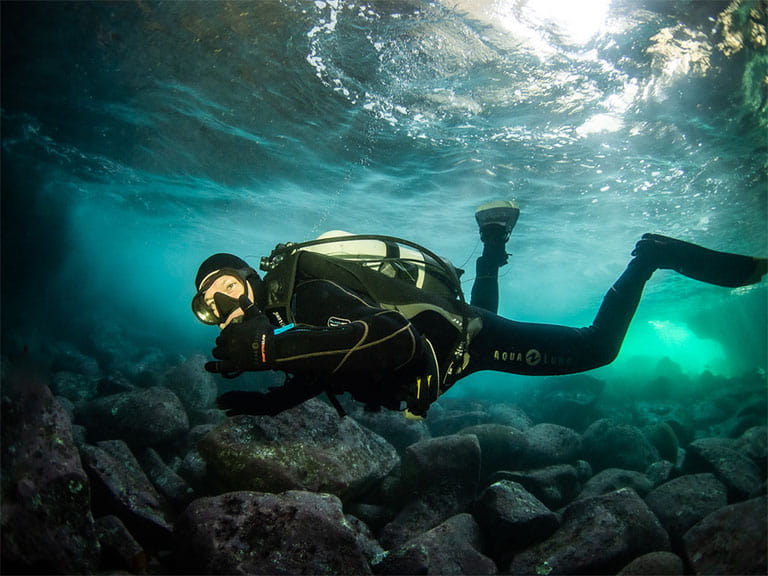
1. You Won’t Feel Too Cold When You’re Diving in Cold Water
We think that cold water diving is like snowboarding.
Yes, your surroundings are cold, and every now and then you’ll feel the chill.
But the cold is manageable when you’re snowboarding because you’re constantly moving your body and having fun. You’re also wearing exposure protection that keeps you warm. (You wouldn’t go snowboarding in your swimsuit, would you?)
When you go diving in cold water, you’ll wear either a thick wetsuit or a drysuit. Here in San Diego, where the water temperature ranges from 50 to 67 degrees Fahrenheit, most divers wear 7mm wetsuits, with a hood, booties, and gloves. It might be cumbersome to put on a wetsuit if you’ve never done it before, but you’ll forget you’re wearing it by the time you get in the water.
Wetsuits trap a small amount of water against your body, and your body naturally heats up that water and creates warmth.
If you’re going to scuba dive in water that’s cooler than 50 degrees, you’ll probably wear a drysuit. A drysuit, as the name implies, keeps your body dry and is the warmest type of exposure protection available.
If you’re a freediver, you’ll only wear a wetsuit. But you’ll probably be more cold-resistant than a scuba diver because:
- You’ll be using your body a lot more
- You’ll be surfacing every so often–so if you’re diving in a Mediterranean climate, you’ll get to enjoy the warmer surface temperature every time you come up for air (this is the case for freedivers in San Diego)
Remember that “cold water diving” is a pretty loose term. For some divers, “cold water” means ice diving or sub-antarctic diving. Other divers use it to refer to temperate water environments (water that’s roughly between 50 to 75 degrees Fahrenheit).
2. Cold Water Environments are Unique
In cold water, you won’t find gigantic coral reefs or endless caravans of fish. But there’s a lot of beauty to be found in cold-water ecosystems that can only be found in cold-water ecosystems.
Here are some of the habitats you’ll discover in the cooler parts of the ocean:
- Kelp Forests
- Glaciers and Iceberg Fields
- Seagrass Meadows
- Lakes / Quarries
- Mating / Migration Areas for Sharks and Whales
But let’s not forget to mention lakes! There’s a lot of beauty to be found in freshwater habitats, too, from unique species of fish to geologic formations and archaeological finds.
Coldwater habitats are critically important to our planet. Kelp forests, mangroves, and algae-rich habitats produce most of the oxygen that’s given to us by the ocean, and they’re more effective at removing carbon dioxide from our atmosphere than even the rainforests.
Truth is, we wouldn’t have beautiful tropical reefs without all the work that’s being done in cold-water habitats.

3. Kelp Forests Can Only Be Found in Cold Water
If you’re a scuba diver or freediver, you MUST dive in a kelp forest at least once in your life.
A kelp forest is just like what it sounds–it’s a gorgeous, underwater forest of kelp.
Kelp forests are usually composed of giant kelp or bull kelp, with a few other kelp species mixed in. They provide food and shelter to all sorts of fish, sharks, and invertebrates. But most divers want to visit the kelp forest for the beauty of the kelp itself. There are few experiences as awe-inspiring as swimming through the massive stripes of giant kelp, which sometimes form thick canopies on the ocean surface.
Kelp forests are only found in cold water, so doing a cold water dive is the only way you’re going to check this one off your bucket list.
4. There’s World-Class Diving in Cold Water
A kelp forest is not the only incredible diving you can do in cold water. Here are just a few amazing underwater experiences that require wetsuits or drysuits:
- South African Sardine Run: The sardine run in South Africa is one of the ocean’s most famous spectacles when a large migration of sardines creates a feeding frenzy for dolphins, sharks, and whales.
- Shark Diving: Speaking of South Africa, there tends to be great shark diving in cooler waters–from baited shark dives to great white cage diving.
- Ice Diving: Diving under a glacier is an experience that’s completely otherworldly.
- Cave Diving: If you ever want to try cave diving, you’ll most likely have to wear a wetsuit or a drysuit. Underwater caves usually feature stunning rock formations and fossils.
- Diving a Tectonic Plate: The Big Crack is a famous diving destination where you can touch both the North American and Eurasian plates all situated in Pingvallavatn Lake in the Pingvellir National Park, Silfra Island.
- Diving in Lakes or Rivers: Lakes and rivers tend to be cooler. In freshwater, you can spot unique species of fish or discover fossils or artifacts. And if you’re living in a landlocked area, you may have few other options for local diving, anyway.
- Diving with Sea Lions and Sea Otters: Sea lions and sea otters are some of the most beloved creatures in the ocean. They mostly hang out in cooler water–hence their blubber and their fur, respectively.
Don’t forget: some of the best underwater experiences in the world are in cold water.
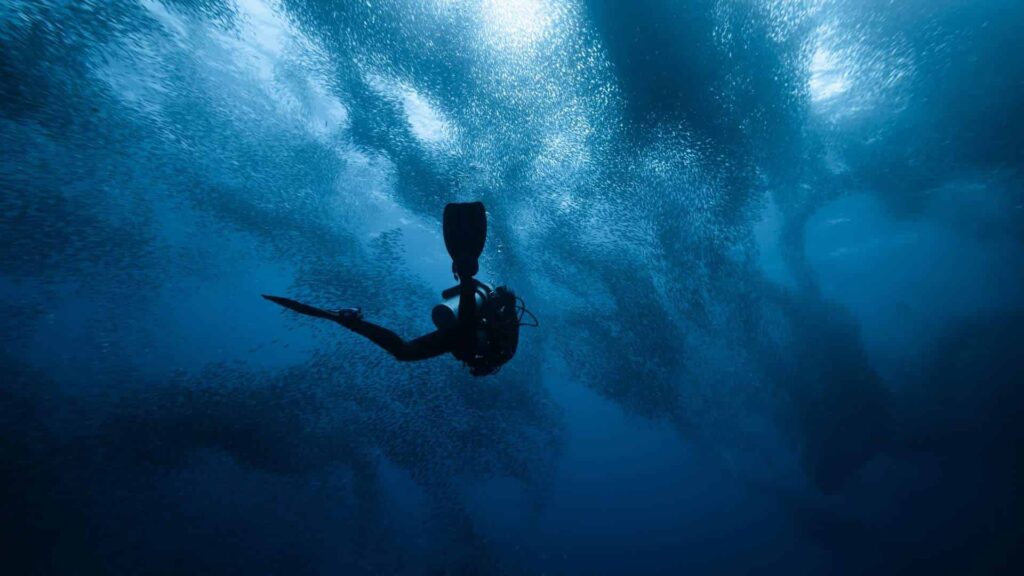
5. Cold Water Divers are Better Travelers
Most divers go to the same type of location over and over and over again: a place that’s humid and tropical, with white, sandy beaches and a healthy number of all-inclusive resorts and first-class amenities.
Not that we don’t like tropical beaches or flashy resorts, but there are so many beautiful places to see in the world and you don’t want to be stuck in the tropics all the time.
Coldwater divers tend to travel more broadly than scuba divers who can only dive in warm water.
Tropical divers are mostly limited to the Caribbean, Southeast Asia, the South Pacific, and a few places near the Indian Ocean–basically, any region near the equator.
But if you’re a cold water diver, the world is your oyster, so to speak.
Coldwater divers will happily travel to the snowy ridges of Patagonia, the wild shorelines of southern Africa, or the wreck-filled waters of northern Europe.
If you can dive in cold water, then you can dive anywhere. Thus, you’ll be motivated to travel everywhere.
6. Cold Water Diving Will Make You a Better Diver
Coldwater diving is not bad diving, but it can be harder diving. The visibility is not as good in cold water, and in some places, you might have to deal strongly with currents or surge.
Coldwater will force you to use many of your scuba skills that you may never have to use when you’re diving in water that’s clear and calm. You’ll get more accustomed to using your compass and doing underwater navigation, and you’ll get plenty of opportunities to refine your buoyancy skills and air conservation techniques. Improving these skills will make you a better, safer scuba diver.
The same is true for freediving. Coldwater makes your muscles more tense and it can be harder to relax before you make a descent. It’s a great training environment and will help you refine your breath holding and relaxation techniques.
When you get back to the tropics, you’ll find that diving is easier than ever. In actuality, you’re just a better diver because of your cold water experiences.
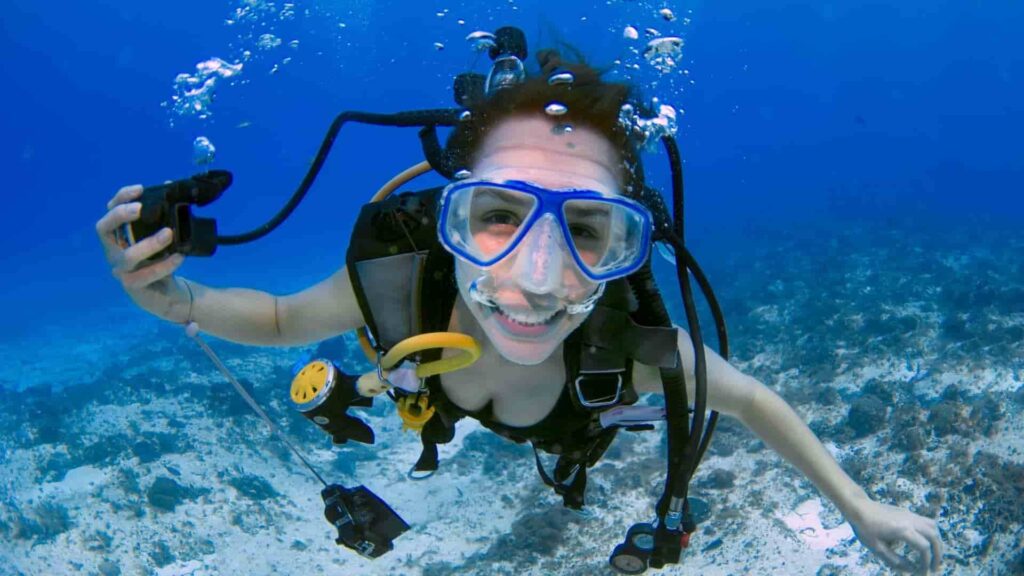
7. If You Can Dive in Cold Water, You Can Dive More Often
There are a lot of people who live in places where there’s only cold water diving. They don’t want to dive in cold water, so they only go scuba diving once or twice per year when they go on vacation.
That’s depressing, isn’t it?!
Maybe it’s the aquatic mammal in us, but we get anxious, sad, and downright crazy when we’re forced to be out of the water for a long time.
Once you discover the joy of cold water diving, you’ll be able to go diving throughout most of the year, even when you’re not on vacation.
Diving has many health benefits, and you’ll be a healthier, happier person the more frequently you do it.
Tips for Diving in Cooler Water
Never gone diving in cold water? Nervous to try it?
Don’t worry! At Dive California, we meet so many divers who are jumping into cold water for the first time. We’ve come up with a few helpful tips for those of you who want to take the plunge.
- Go Someplace Warm: If you’re trying cold water diving for the first time, it’s best to go somewhere in which the water is cold, but the surface temperature is warm (*cough* San Diego *cough*). The warm air will make the cold water feel less intimidating. In fact, by the time you slip into your wetsuit, you might be a little sweaty and be actually craving the cold water.
- Dive with a Guide: It’s best to dive with a guide the first time you tackle a cold water habitat. A qualified dive guide will do the navigation for you and give you helpful tips on dealing with the visibility and other water conditions.
- Get the Right Gear: You don’t want to do cold water diving without the proper exposure protection. Wetsuits and drysuits are expensive, but the best dive operators will provide rental equipment for you (Dive California provides full dive gear for our scuba tours and freediving students).
- Try a Shore Dive: In cold water, shore diving tends to be easier than boat diving. Coldwater is usually rougher than the tropics, and you’re likely to get seasick on a boat dive, even if you’re using seasickness medication. In some places, like California, boat dives are not led by divemasters–you’ll have nobody leading you underwater, so you’ll have to plan and execute your own dive. If it’s your first time in cold water, it’s best to do a guided dive straight from shore.
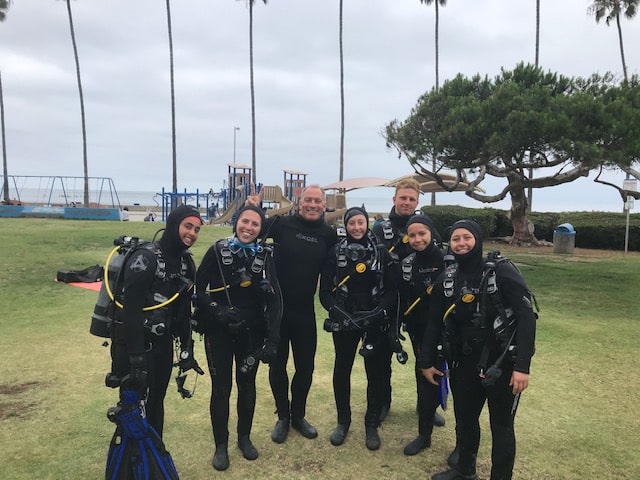
Now you’re ready to don your wetsuit / drysuit and discover all the beauty of a cold water habitat. Safe diving!


